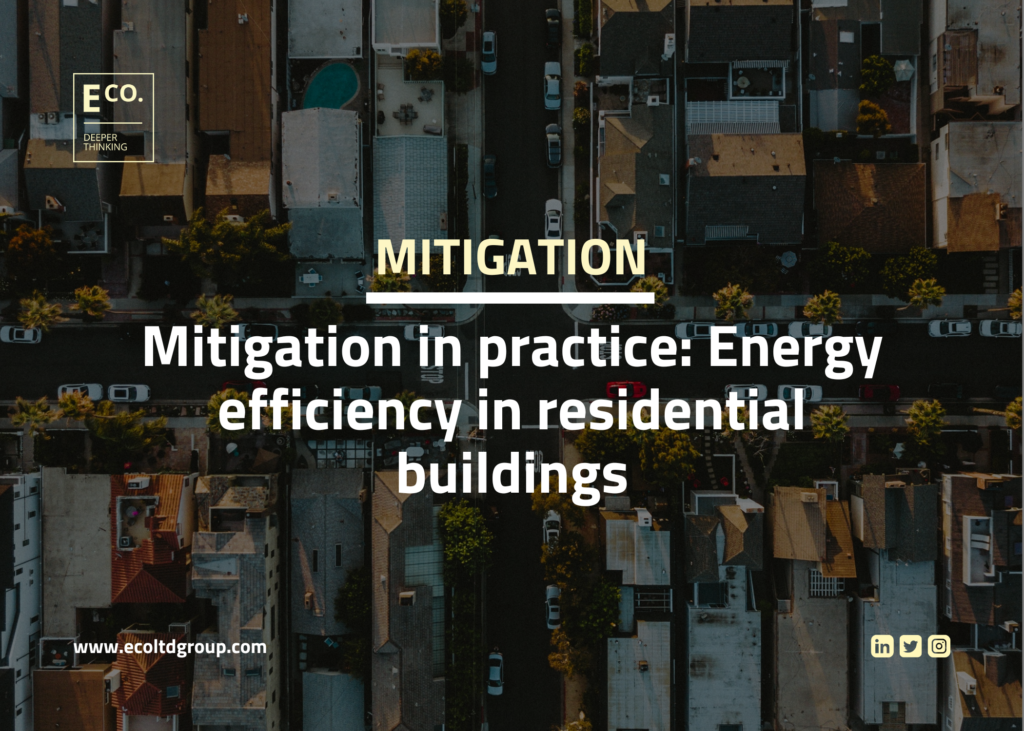Mitigation in practice: Energy efficiency in residential buildings
12 September 2023, Category: All insights, News, Tags: buildings, climate change, climate finance, energy efficiency, mitigation

Residential buildings are one of the most commonplace types of buildings we have, from standalone houses to large flat complexes, and the rates of energy efficiency in residential buildings is a current global problem. According to the International Energy Agency, ‘The operations of buildings account for 30% of global final energy consumption and 26% of global energy-related emissions’ [1]. If we are to include the emissions produced by building construction, we reach a number closer to 40% of total global CO2 emissions. If the national and international climate goals set through the Paris Agreement, Nationally Determined Contributions, and other binding legislation are to be met, nations must address decarbonisation within the building sector.
In 2021, the investments made in energy efficiency in buildings grew by 16% (to a whopping USD 237 billion), but operations-related CO2 emissions grew by 5% from the previous year [2]. This is important if we consider that in 2040, approximately two-thirds of the global building stock will be buildings that exist today [3]. If those two-thirds cannot be made energy efficient, we will still see high levels of operations-related CO2 emissions.
In short, those calling for greater accountability in the building sector for the emissions produced are fighting a battle on two fronts: reducing embodied carbon and reducing operational carbon. So how can we confront this solely for residential buildings?
This article will consult the key moving parts in this corner of the mitigation world, covering these topics:
- Breaking down residential emissions
- Addressing energy efficiency in residential buildings
- Overall recommendations for greater mitigation potential
Breaking down residential emissions
It is difficult to ascertain the level of global CO2 emissions produced by residential buildings. Most studies have either focused on a specific country or a specific type of building material [4]. Of course, levels produced will not be universal country to country – or even city to city. Like historical CO2 emissions, it will be the case that most of the global CO2 emissions from residential buildings are produced by developed, high-earning nations.
For example, in the UK, 87 MtCO2e were produced by buildings in 2019. Of this, 77% was produced by residential buildings, 14% by commercial buildings, and 9% by public buildings [5]. Similarly, 59% of electricity consumed in the UK is by buildings, with the largest share of this stemming from the use of appliances and lighting in homes.
Future impacts of the building sector are projected to be quite different from the current scenario. One report states that lower and middle-income countries will see a high emissions increase, from 750 Mt in 2020 to 2.4 Gt in 2060 [6]. We can also look at individual countries’ projected changes – the Global Buildings Performance Network estimates that at the rate of India’s growth, building energy consumption and CO2 emissions in the country could increase by 700% by 2050 if left unchecked [7].
When it comes to the implementation of low-carbon policies for the buildings sector, the regulatory landscape is a complex minefield of tradeoffs, implications, and differing agendas. For example, do local governments have the resources and capacity to enforce new building standards should they be enacted? That’s not the only question that needs addressing:
- Will higher energy efficiency residential buildings utilise more building materials to construct?
- Is it easier, either from a financial or technical viewpoint, to build new energy-efficient residential buildings or to improve the energy efficiency of the ones we already have?
- With the rapid increase in the demand for new buildings, will nations eschew energy efficiency for less efficient buildings that can be made both faster and cheaper?
From that regulatory viewpoint, the first thing that governments must contend with is embodied carbon. Embodied carbon is the carbon produced in the production of materials, the building process, and the decommissioning process. For example, a cubic metre of brick produces embodied emissions of around 357kg of CO2 [8].
Embodied carbon is the counterpart to operational carbon, which is the carbon emitted during the use of a building. Operational carbon is simpler to measure and analyse than embodied carbon, which is one reason why improving the energy efficiency of a building is one of the first things focused on in reducing carbon emissions.
At the moment, embodied carbon has a varied regulatory position across the globe. For example, in the UK, even with the 2050 target for net zero emissions, the requirements to report on embodied carbon in construction are merely voluntary and not legally binding. A 2022 research paper from the UK Department for Business, Energy, and Industrial Strategy (BEIS) stated that stakeholders found that current regulations ‘are not driving holistic low carbon designs, or addressing embodied carbon, building performance in use, post occupancy engagement activities and simplicity for users.’ [9] The same paper suggests that, with new technology and approaches to assessing embodied carbon, the process is easier, and so regulation should begin to reflect that.
Modern studies have suggested that from 2020 to 2040, embodied carbon will represent 57% of the total carbon emissions of global new construction with no building sector interventions [10].
Addressing energy efficiency in residential buildings
One immediate change that can be made is evidently a behavioural change. Investors are in an advantageous position to apply pressure on markets to decrease investments in non-energy-efficient buildings. The majority of owners are quite able to refit residential buildings to energy-efficient standards – the introduction of energy-efficient lighting and appliances, caulking and weather stripping, and air sealing (among other methods). But above and beyond this, governments must first take action to create the imperative for energy efficient and zero carbon buildings.
For example, in the EU, governments could work to double the annual energy renovation rate of residential (and non-residential) buildings, which by 2030 could reduce a building’s energy consumption by up to 60% [11]. As of 2022, around 140 countries have net zero targets [12], but these will be impossible to achieve without a dedicated governmental effort to legislate for zero-carbon, energy-efficient residential buildings (alongside non-residential buildings).
Of course, energy-efficient home policies are currently few and far between. Additionally, these only target operational carbon. A truly adequate energy efficiency approach for residential buildings must account for embodied carbon within the lifecycle of a building. This would bring material benefits, such as growth in the recycled materials market, alongside a decrease in the amount of embodied carbon.
Overall recommendations for greater mitigation potential
The building and construction sector is seeing improvements in commitments towards sustainability, but stalled progress when it comes to practical changes. In 2021, there was:
- A 27.4% increase in countries with building energy codes;
- A 79.5% in the amount of NDCs which mention buildings.
However, there was also:
- A decrease in decarbonisation level to 8.1 points (down from 11.3 in 2020);
- A 3-point increase in the gap between observed performance and desired pathway of a zero-carbon building stock;
- A 4% increase in operational energy demand.
All of these metrics are taken from UNEP’s 2022 Global Status Report for Buildings and Construction [X] There are countless more statistics that paint a varied picture of progress globally.
Recommendations are contextual in nature. Due to the highly fragmented geographical and regulatory environment found when considering cities in a global context, mitigation strategies that work in one city may not be applicable in another. However, there are several potential solutions to decrease the emissions profile associated with residential buildings.
Develop long-term decarbonisation strategies
If governments are able to develop long-term decarbonisation strategies (that fit within their net-zero pledges), decision-makers can begin to enact shorter-term actions that work to achieve the objectives of said strategies. Similarly, these strategies will help either create or implement better energy efficiency standards across both building construction and operations.
Build public awareness of behavioural changes
Arguably, it is more important that governments implement decarbonisation mandates, yet without general behavioural change, there can be little progress. Yet, the relationship between these two practices is cyclical, and markets help to dictate how government decisions are made.
Implement zero-carbon-ready building standards
Again, this is a government-led policy change, one that is an essential tool for ensuring energy-efficient performance through a building’s lifecycle. All countries should include life cycle emissions and requirements for resiliency in their energy codes, with these recommendations helping produce buildings that are initially greener to build and better at adapting to changing climates.
Develop financial mechanisms that stimulate increased use of energy-efficient products
As previously stated, markets help dictate both top-down and bottom-up action. If developers have access to finance, and if said investments (such as energy-efficient technologies, renewable energy, and recycled building materials) are de-risked, the attractiveness and ease of their use will improve dramatically.
These are just a small number of recommendations, as there are many more measures that aid the energy efficiency of residential buildings and the overall move towards better, more universal mitigation strategies. Do you have any recommendations? Let us know in the comments below.

Looking for insight into climate finance? Look no further
Get in touch with our climate finance consultants to discuss a project you’re working on and create successful, fit-for-purpose projects, now and in the future. Email us at: amy@ecoltdgroup.com or find us at the following:
 |
 |
 |
References
-
IEA, 2022. Buildings. Available online at: <https://www.iea.org/energy-system/buildings>
-
UNEP, 2022. CO2 emissions from buildings and construction hit new high, leaving sector off track to decarbonize by 2050: UN. Available online at: <https://www.unep.org/news-and-stories/press-release/co2-emissions-buildings-and-construction-hit-new-high-leaving-sector>
-
Architecture 2030, 2022. Why the built environment? Available online at <https://architecture2030.org/why-the-built-environment/>
-
Zhong, X., Hu, M., Deetman, S. et al. Global greenhouse gas emissions from residential and commercial building materials and mitigation strategies to 2060. Nat Commun 12, 6126 (2021). Available online at: <https://www.nature.com/articles/s41467-021-26212-z>
-
Climate Change Committee, 2020. The Sixth Carbon Budget: Buildings. Available online at <https://www.theccc.org.uk/wp-content/uploads/2020/12/Sector-summary-Buildings.pdf>
-
Zhong, X., Hu, M., Deetman, S. et al. Global greenhouse gas emissions from residential and commercial building materials and mitigation strategies to 2060. Nat Commun 12, 6126 (2021). Available online at: <https://www.nature.com/articles/s41467-021-26212-z>
-
GBPN, 2013. Mitigation Potential From India’s Buildings. Available online at: <https://www.gbpn.org/wp-content/uploads/2021/06/03.India_ExecutiveSummary_0.pdf>
-
Jankovic, L., et al., 2021. How can UK Housing Projects be Brought in Line With Net-Zero Carbon Emission Targets? Front. Built Environ., 29 November 2021, Volume 7. Available at: <https://www.frontiersin.org/articles/10.3389/fbuil.2021.754733/full>
-
BEIS, 2022. Building for 2050 Low cost, low carbon homes. Available online at: <https://assets.publishing.service.gov.uk/government/uploads/system/uploads/attachment_data/file/1121448/Building_for_2050_Low_cost_low_carbon_homes.pdf>
-
Architecture 2030, 2022. Why the built environment? Available online at <https://architecture2030.org/why-the-built-environment/>
-
European Commission, 2020. Stepping up Europe’s 2030 climate ambition: Investing in a climate-neutral future for the benefit of our people. Available online at: <https://eur-lex.europa.eu/resource.html?uri=cellar:749e04bb-f8c5-11ea-991b-01aa75ed71a1.0001.02/DOC_1&format=PDF>
-
Climate Action Tracker, 2022. CAT net zero target evaluations. Available online at: <https://climateactiontracker.org/global/cat-net-zero-target-evaluations/#:~:text=As%20of%20November%202022%2C%20around,%25%20emissions%2C%20in%20May%202021.>
Join the conversation by posting a comment below. You can either use your social account, by clicking on the corresponding icons or simply fill in the form below. All comments are moderated.